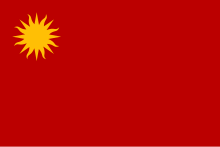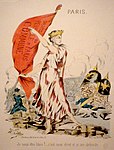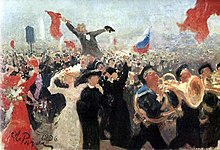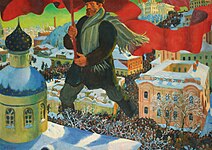Red flag (politics)

In politics, a red flag is predominantly a symbol of left-wing politics, including socialism, communism, Marxism, labour movement, and anarchism. The originally empty or plain red flag has been associated with left-wing politics since the French Revolution (1789–1799).[1]
Socialists adopted the symbol during the
Prior to the French Revolution and in some contexts even today, red flags or banners were seen as a symbol of defiance and battle.[2]
History


Red color as a combat or revolt symbol in Europe goes back to the turn of the millennia and before. In the Middle Ages, ships in combat flew a long red streamer called the baucans to signify a fight with no quarter.[3]
The red cap was a symbol of popular revolt in France going back to the
Inverting the original symbolism, the
British sailors

Two red flags soaked in calf's blood were flown by marchers in South Wales during the Merthyr Rising of 1831. It is claimed to be the first time that the red flag was waved as a banner of workers' power. The red flags of Merthyr became a potent relic following the execution of early trade unionist Dic Penderyn (Richard Lewis) in August 1831, despite a public campaign to pardon him.
During the Battle of the Alamo in March 1836, General Antonio López de Santa Anna of Mexico displayed a plain red flag (approx. 10 feet square) from the highest church tower in Béjar. The meaning of this display – directed to the Alamo defenders – meant "no surrender; no clemency." [citation needed]

At much the same time, the Liberal "Colorados" in the Uruguayan Civil War used red flags. This prolonged struggle at the time got considerable attention and sympathy from liberals and revolutionaries in Europe, and it was in this war that Giuseppe Garibaldi first made a name for himself and that he was inspired to have his troops wear the famous Red Shirts.
The Ottoman Empire used a variety of flags, especially as naval ensigns, during its history. The star and crescent came into use in the second half of the 18th century. A buyruldu (decree) from 1793 required that the ships of the Ottoman Navy were to use a red flag with the star and crescent in white. In 1844, a version of this flag, with a five-pointed star, was officially adopted as the Ottoman national flag.
In 1870, following the stunning defeat of the French Army by the Germans in the Franco-Prussian War, French workers and socialist revolutionaries seized Paris and created the Paris Commune. The Commune lasted for two months before it was crushed by the French Army, with much bloodshed. The original red banners of the Commune became icons of the socialist revolution; in 1921, members of the French Communist Party came to Moscow and presented the new Soviet government with one of the original Commune banners; it was placed (and is still in place) in the tomb of Vladimir Lenin, next to his open coffin.[7]
With the victory of the Bolsheviks in the Russian Revolution, the red flag, with a star symbolizing the party, hammer to symbolize the workers and sickle to symbolize peasants, became the official flag of Russia, and, in 1923, of the Soviet Union. It remained so until the breakup of the Soviet Union in 1991.
After the Chinese Communist Party (CCP) came to power in 1949, the flag of China became a red flag with a large star symbolizing the CCP, and smaller stars symbolizing workers, peasants, the urban middle class and rural middle class. The flag of the CCP became a red banner with a hammer and sickle. In the 1950s and 1960s, other Communist governments such as Vietnam and Laos also adopted red flags. Some Communist countries, such as Cuba, chose to keep their old flags; and other countries used red flags which had nothing to do with Communism or socialism; the red flag of Nepal, for instance, represents the national flower.
-
A French soldier takes down a red flag from the barricades during the Paris uprising of 1848.
-
A poster from the Paris Commune (1871)
-
A demonstration in Moscow during the unsuccessful Russian Revolution of 1905, painted by Ilya Repin.
-
Red was the color of the Russian Revolution in 1917. The Bolshevik, painting by Boris Kustodiev (1920).
-
Flag of the Soviet Union (1980–1991). The hammer symbolized workers, the sickle represented farmers, and the red star symbolized the Communist Party.
-
Flag of the People's Republic of China. Red symbolizes revolution, the large star is the Communist Party, and the smaller stars represent the working class, the farmers, and the urban middle class, the rural middle class, as described by Mao Zedong.
-
Flag of Socialist Republic of Vietnam. Red symbolizes revolution, the five-point star symbolizes intellectuals, farmers, workers, traders and soldiers.
-
Flag of the Workers' Party of Korea. The hammer represents workers, the sickle represents farmers, and the paint brush represents the artisans.
-
Flag of the People's Republic of the Congo (1970–1991). Red symbolizes the revolution, the star represents communism, while hammer and hoe symbolize workers.
Symbol of communism and socialism
During the

The banner of the
The building to have had a red flag flying for the longest period of time and to still have one is the Victorian Trades Hall in Melbourne, Australia. It is the world's oldest trade union building. The flag has been flying for over a century.
Usage by anarchists
The red flag was one of the first anarchist symbols worldwide prior to the October Revolution, after which red flags started to be associated with Bolshevism and authoritarian socialism.[11]
British Labour Party
The red flag was the emblem of the British
Communist and socialist red flag as name or title
It has been common to find streets, buildings, businesses and product brands named after the Red Flag in nominally socialist countries as a result of
Historical laws banning red flags
After the suppression of the 1848 revolution, the red flag and other insignia dominated by the colour red were banned in Prussia, as was the case in France after the demise of the Paris Commune.[15] During the persecution of socialists during the Red Scare of 1919–1920 in the United States, many states passed laws forbidding the display of red flags, including Minnesota, South Dakota, Oklahoma,[16] and California. In Stromberg v. California, the United States Supreme Court held that such laws are unconstitutional.[17]
In Australia the red flag was similarly banned in September 1918 under the War Precautions Act 1914. This ban would be an arguable cause of the Red Flag riots. The ban ended in Australia with the repeal of the War Precautions Act in 1920.
See also
- Bandiera Rossa
- Anarchist flag(⚑)
- Communist symbolism
- Flag of Albania
- Flag of Angola
- Flag of Belarus
- Flag of China
- Flag of Kyrgyzstan
- Flag of Mongolia
- Flag of Montenegro
- Flag of North Macedonia
- Flag of the Soviet Union
- Flag of Vietnam
- Green flag
- Hammer and sickle (☭)
- "The Red Flag"
- Red flag in racing
- Red flag warning
- Red star (★)
- The Standard of Revolt
- White flag
References
- ^ Brink, Jan ten Robespierre and the Red Terror, (1899).
- ^ Cited in "red flag," Oxford English Dictionary.
- ^ Flags of the World, "Baucans (or Bauccedillian)".
- ^ Thomas Carlyle, French Revolution, p. 408.
- ^ Flags of the World, "French Revolution"
- ^ "Socialist History of the French Revolution"
- ^ von Geldern, James (1993). Bolshevik Festivals 1917–21. Berkeley: University of California Press. p. 178. Archived from the original on November 26, 2018. Retrieved November 26, 2018.
- ^ Nour, “L’Histoire du croissant,” p. 66/295. See also Ibn Khaldun, Muqaddimah, pp. 214–15.
- ^ Flags of the World, "France"
- ^ a b Flags of the World, "Soviet"
- ^ "Barwy anarchistyczne: Skąd czarne i czarno-czerwone flagi?" [Anarchist colours: Where are black and black-red flags from]. cia.media.pl (in Polish). Centrum Informacji Anarchistycznej. June 19, 2012. Archived from the original on February 24, 2021. Retrieved September 4, 2016.
- ^ 1997年阿克陶县行政区划 [1997 Akto County Administrative Divisions] (in Simplified Chinese). XZQH.org. December 31, 2010. Archived from the original on January 22, 2020. Retrieved September 30, 2020.
皮拉勒乡 1958年成立皮拉勒公社,1967年更名红旗公社,1984年改设皮拉勒乡。
- Google Cache, Internet Archive.
- ^ 1997年乌恰县行政区划 [1997 Ulugqat County Administrative Divisions] (in Simplified Chinese). XZQH.org. December 31, 2010. Archived from the original on October 15, 2017. Retrieved October 5, 2020.
巴音库鲁提乡 {...}1950年成立巴音库鲁提三乡,1962年建巴音库鲁提公社,1968年更名红旗公社,1984年改设巴音库鲁提乡。
- ^ Balz, Hanno. "'Hostile take-over'. A political history of the red flag". Socialist History. 59: 8–30.
- ^ Zechariah Chafee, Jr., Freedom of Speech (NY: Harcourt, Brace and Howe, 1920), 180ff., Appendix V
- ^ Stromberg v. California, 283 U.S. 359 (1931).
External links
![]() Media related to Red flags at Wikimedia Commons
Media related to Red flags at Wikimedia Commons
- Red flag of Socialism at Flags of the World
- Auguste Blanqui, For the Red Flag, 1848.









